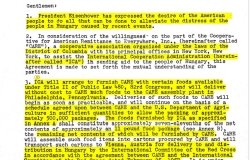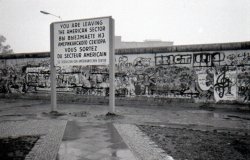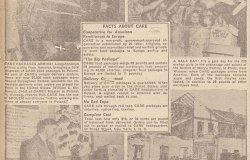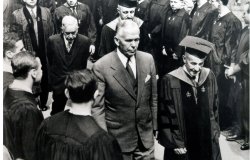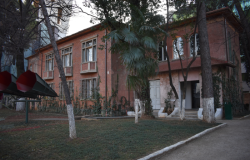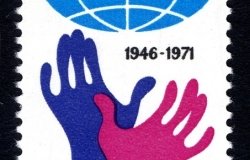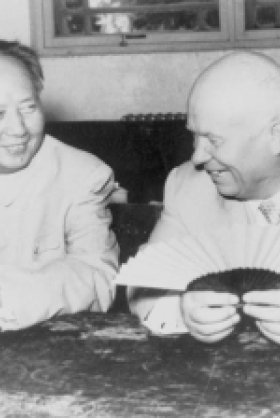The Manhattan Project and its Cold War Legacy
Cynthia C. Kelly, Atomic Heritage Foundation, William Lanouette, writer and policy analyst, Robert Furman, retired Army Major, and head of the first atomic intelligence unit, and James Hershberg, The George Washington University,
Overview
On Wednesday, February 20, 2008, the Cold War International History Project and the Atomic Heritage Foundation co-sponsored a discussion of the Manhattan Project and its legacy. The speakers included Cynthia C. Kelly, founder and president of the Atomic Heritage Foundation; William Lanouette, author of Genius in the Shadows: A Biography of Leo Szilard, the Man Behind the Bomb (1992 and 1994); Robert Furman, a veteran of the Manhattan Project's atomic intelligence unit; and James G. Hershberg, associate professor of history and international affairs at the Elliot School of International Affairs, George Washington University.
In her brief introduction, Kelly described the work of the Atomic Heritage Foundation, explaining that one of the ways they preserve the history of the Manhattan Project is through oral histories, over 100 of which were used to recreate the spirit of the time in the new book, The Manhattan Project: The Birth of the Atomic Bomb in the Words of Its Creators, Eyewitnesses and Historians.
Lanouette addressed the historical context and legacy of the Manhattan Project, a secret federal program initiated in June 1942 that blended theoretical science and industrial technology and cost the equivalent of $20 billion in today's dollars. He commented that alongside the moon landing and the Marshall Plan, the Manhattan Project is generally held as a paragon of good management for federal projects conducted on the grand scale. He argued, however, that the unique circumstances in which it operated prevent it from serving as a model for successful government action. General Groves had a practically unlimited budget at his disposal to achieve purely technical-scientific goals; additionally, the Project was established within an existing military structure. The secrecy of the Project protected it from public scrutiny, but also stifled the scientists and later allowed for the ruin of J. Robert Oppenheimer's career and credibility. One of the most "costly" legacies of the Project is the fact that federal money continues to dominate scientific research to this day and that the nine national atomic research laboratories involved in the Project have since lost direction because they were never integrated with other scientific missions.
Robert Furman told the audience how in 1943, General Leslie R. Groves, the military leader of the Manhattan Project, recruited him to head the Project's atomic intelligence unit; the two had previously worked together on the construction of the Pentagon. Furman explained that during WWII, the US did not have a national intelligence program. By 1943, however, it was necessary to acquire information on the German nuclear program because the Manhattan Project scientists were paralyzed by the fear that the Germans would develop and use the bomb first. Under the Alsos Mission, Furman traveled throughout Europe, meeting with scientists and eventually concluding that the Germans had scaled back their nuclear program. Furman emphasized that the focus of the Manhattan Project throughout was on winning the war; German competition was secondary and Russian nuclear development was only a peripheral concern. He noted that the Project launched the world into the nuclear age, making one of its legacies the ongoing problem of nuclear proliferation.
The decision to drop the bomb at the end of WWII, Hershberg contended, displayed the bomb's destructive power. Several plans for nonproliferation developed. A committee of scientists under the chairmanship of Dean Acheson and David Lilienthal put forward the Acheson-Lilienthal Plan, which called for the transparent collaboration of international scientists to monitor the creation and development of nuclear power plants. Andrei Gromyko, then the Soviet representative on the UN Security Council, proposed an alternative plan calling for the destruction of all nuclear arsenals and a subsequent policy of nuclear containment. While both plans were ultimately rejected, they figure into a great paradox of the Manhattan Project: the scientists' struggle to balance the short-term objective of winning the war with the fear of the long-term consequences of nuclear power. It was the hope of several of them that the use of the bomb would push the world toward taking radical political action to prevent WWIII. That nuclear war has not occurred for over 60 years is the least likely of the outcomes foreseen by Manhattan Project scientists.
Following the presentations, the panelists further debated the legacy of the Manhattan Project. Bob Furman reminded everyone that the focus received by the Project during the Cold War was simply not part of the concerns of all the staff and scientists at the time. Their mission was to develop the bomb to win the war. Lanouette pointed out the paradox that the Manhattan Project was launched in 1942, at the same time that the Germans decided that building a bomb would not be a priority. Hershberg noted a final legacy of the Project: its secrecy led to the birth of the national security state, in which information is declared secret unless cleared otherwise.
Christian F. Ostermann, Director, History and Public Policy Program
Drafted by Rachel DeHart
Hosted By

Cold War International History Project
The Cold War International History Project supports the full and prompt release of historical materials by governments on all sides of the Cold War. Through an award winning Digital Archive, the Project allows scholars, journalists, students, and the interested public to reassess the Cold War and its many contemporary legacies. It is part of the Wilson Center's History and Public Policy Program. Read more

History and Public Policy Program
The History and Public Policy Program makes public the primary source record of 20th and 21st century international history from repositories around the world, facilitates scholarship based on those records, and uses these materials to provide context for classroom, public, and policy debates on global affairs. Read more

Nuclear Proliferation International History Project
The Nuclear Proliferation International History Project is a global network of individuals and institutions engaged in the study of international nuclear history through archival documents, oral history interviews, and other empirical sources. At the Wilson Center, it is part of the Wilson Center's History and Public Policy Program. Read more
Thank you for your interest in this event. Please send any feedback or questions to our Events staff.
